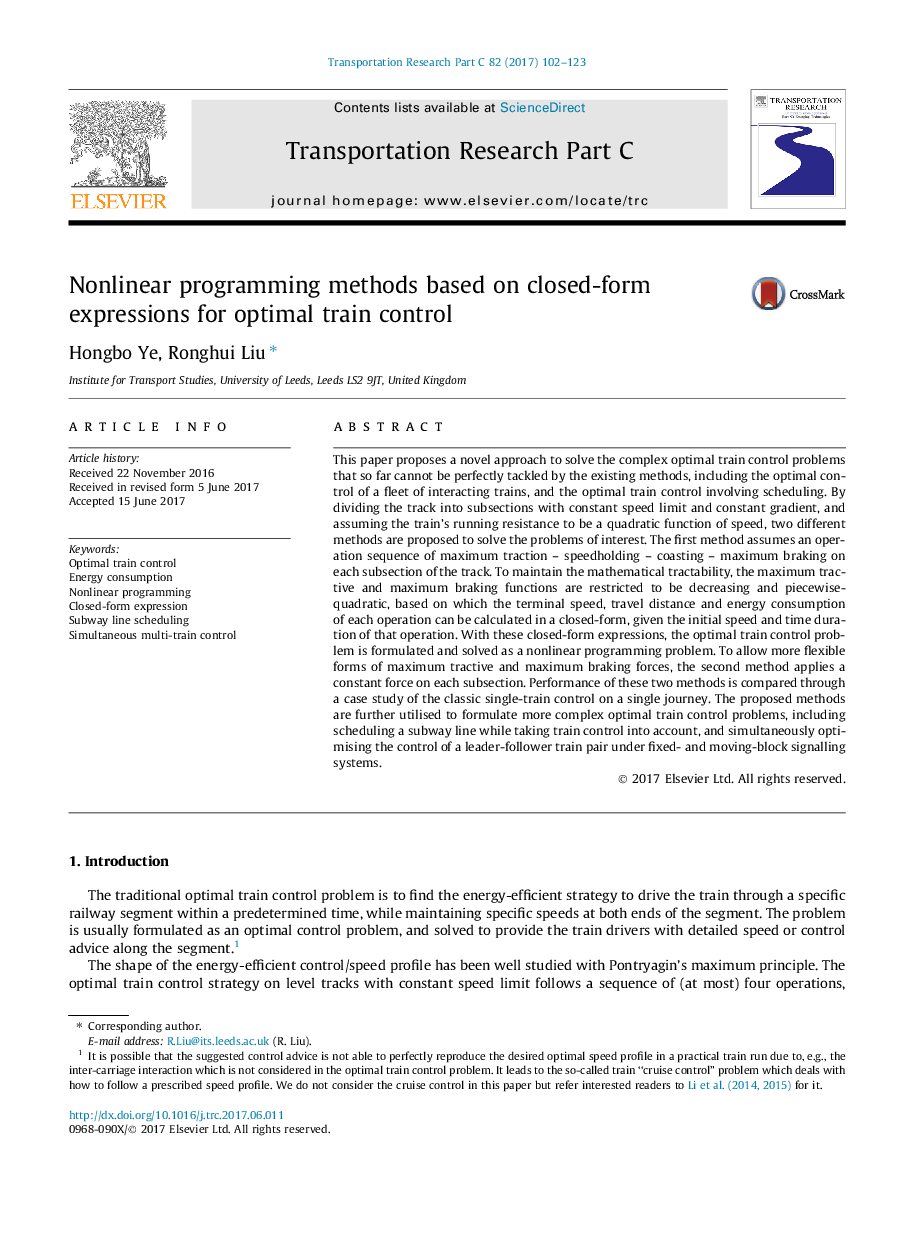| کد مقاله | کد نشریه | سال انتشار | مقاله انگلیسی | نسخه تمام متن |
|---|---|---|---|---|
| 4968484 | 1449666 | 2017 | 22 صفحه PDF | دانلود رایگان |
عنوان انگلیسی مقاله ISI
Nonlinear programming methods based on closed-form expressions for optimal train control
ترجمه فارسی عنوان
روش های برنامه نویسی غیر خطی بر اساس عبارات فرم بسته برای کنترل قطار مطلوب
دانلود مقاله + سفارش ترجمه
دانلود مقاله ISI انگلیسی
رایگان برای ایرانیان
کلمات کلیدی
کنترل قطار مطلوب، مصرف انرژی، برنامه نویسی غیر خطی، بیان فرم بسته برنامه ریزی خط مترو، همزمان کنترل چند قطار،
ترجمه چکیده
این مقاله یک رویکرد جدید برای حل مشکلات پیچیده کنترل قطار بهینه ارائه می دهد که تا کنون نمی تواند با روش های موجود کاملا کنترل شود، از جمله کنترل بهینه ناوگان تعاملات قطار و کنترل قطار مطلوب شامل برنامه ریزی. با تقسیم مسیر به زیرگروه ها با محدودیت ثابت ثابت و شیب ثابت، و فرض بر این که مقاومت در حال حرکت قطار به عنوان یک تابع درجه دوم سرعت است، دو روش مختلف برای حل مشکلات مورد نظر پیشنهاد می شود. اولین روش، یک ترتیب عملیات از حداکثر کشش - سرعت زدایی - ساحلی - حداکثر ترمز در هر قسمت از مسیر را فرض می کند. برای حفظ قابلیت ریاضی، حداکثر توالی ترکیبی و حداکثر محدود کردن کاهش و کوچکال-درجه دوم محدود می شود که براساس آن، سرعت ترمینال، فاصله سفر و مصرف انرژی هر عملیات می تواند در فرم بسته محاسبه شود، مدت زمان و سرعت آن عملیات. با استفاده از این عبارات فرم بسته، مشکل کنترل قطار بهینه سازی شده به عنوان یک مشکل برنامه نویسی برنامه ریزی شده و حل می شود. برای اجازه دادن به فرم های انعطاف پذیر بیشتر از نیروهای حداکثر کششی و حداکثر ترمز، روش دوم نیروی دائمی را در هر بخش اعمال می کند. عملکرد این دو روش با استفاده از یک مطالعه موردی کنترل تک قطار کلاسیک در یک سفر واحد مقایسه می شود. روش های پیشنهادی بیشتر برای طراحی مشکلات پیچیده تر بهینه تر کنترل قطار، از جمله برنامه ریزی خط مترو در حالی که کنترل قطار را به حساب، و به طور همزمان کنترل یک قطار قطار رهبر و پیرو تحت سیستم های سیگنال ثابت و حرکتی را بهینه سازی شده استفاده می شود.
موضوعات مرتبط
مهندسی و علوم پایه
مهندسی کامپیوتر
نرم افزارهای علوم کامپیوتر
چکیده انگلیسی
This paper proposes a novel approach to solve the complex optimal train control problems that so far cannot be perfectly tackled by the existing methods, including the optimal control of a fleet of interacting trains, and the optimal train control involving scheduling. By dividing the track into subsections with constant speed limit and constant gradient, and assuming the train's running resistance to be a quadratic function of speed, two different methods are proposed to solve the problems of interest. The first method assumes an operation sequence of maximum traction - speedholding - coasting - maximum braking on each subsection of the track. To maintain the mathematical tractability, the maximum tractive and maximum braking functions are restricted to be decreasing and piecewise-quadratic, based on which the terminal speed, travel distance and energy consumption of each operation can be calculated in a closed-form, given the initial speed and time duration of that operation. With these closed-form expressions, the optimal train control problem is formulated and solved as a nonlinear programming problem. To allow more flexible forms of maximum tractive and maximum braking forces, the second method applies a constant force on each subsection. Performance of these two methods is compared through a case study of the classic single-train control on a single journey. The proposed methods are further utilised to formulate more complex optimal train control problems, including scheduling a subway line while taking train control into account, and simultaneously optimising the control of a leader-follower train pair under fixed- and moving-block signalling systems.
ناشر
Database: Elsevier - ScienceDirect (ساینس دایرکت)
Journal: Transportation Research Part C: Emerging Technologies - Volume 82, September 2017, Pages 102-123
Journal: Transportation Research Part C: Emerging Technologies - Volume 82, September 2017, Pages 102-123
نویسندگان
Hongbo Ye, Ronghui Liu,
